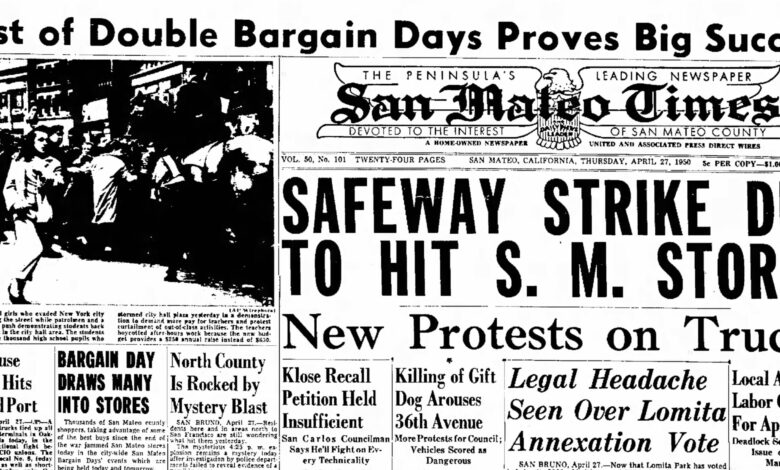UPDATE- SAFEWAY STRIKE CALLED OFF, DEAL MADE SUNDAY. Fort Bragg Safeway was brand new when 1938 strike hit. Unfair! Past century has see dozens strikes and ‘almost’ strikes in ever changing economic landscape

Workers actually went on strike in Colorado but chain made deal with union to end planned Sunday walkout here

Mendocinocoast.news has been updating the Safeway planned action since Friday. Saturday night we were informed there would finally be a walkout on Sunday morning. But instead, the two sides came to terms. Workers are saying Safeway took a black eye from a Colorado strike that did happen earlier this month and wanted to nix the same possibility in California. Here is the emailed notice we got from the union Sunday morning. The chain has not responded to our requests for information.

Safeway strikes have been threatened on a regular basis since the 1930s. Fort Bragg’s store may have averted the big strike in 1938, as it was brand new then. Details about that were hard to come by.
Unions have represented the California grocery king since the beginning, from an AFL union in the 30s to the Teamsters Union in the 1950 strike onto the current unions which issued this statement about the delay. No new strike date has been set.
The attached clippings come from a previous world hard to grasp for the modern consumer. Corporations once battled unions on more or less equal footing. But then mergers and intense anti union propaganda changed the dynamic to where the media generally blames greedy workers for any dispute over pay. Globalism ended the war and corporations got bigger and bigger with the mega merger era that started during the Reagan administration. That’s when the government stopped enforcing antitrust laws. At one time in the 1950s, Congress came just short of banning chain grocery stores. The A&P company’s price manipulations were the subject of two decades of monopoly rulings against it, the nation’s largest retailer. A&P was the Walmart of its time. Safeway, the A&P of the West, was also accused of this and of conspiring with A&P and a court ruling once forbid Safway from owning stores east of the Mississippi and A&P West of the big river.


That all went away as globalism took control, bringing in low priced goods from foreign lands, wheeled by companies beyond the power and scope of the United States government . The media began to spin a tale of how unions were bad and how globalism and its biggest players were all good, a narrative that still dominates today. A&P went bankrupt, ironically from buying up too many competitors too fast, once the legal bounds were loosed. Safeway was devoured by the now larger Albertson’s.
Locally owned stores face a bigger challenge than ever today due to the end of anti trust enforcement against suppliers.
This change is having perhaps the most spectacular effect on grocery prices and competition in history, but has long gone entirely unreported by the news media. Ask anyone who is a supplier how what would have once been criminal practices have now cut out the business of most suppliers and your ability to choose. This change is also much more responsible for the rise in grocery prices than is Biden or Trump.
Ironically, this reporter, who has never crossed a picket line, would be forced to in this case to get family medicines at Safeway pharmacy. The local pharmacy we use for almost all our medications cannot get them in stock to fill. That’s because of a criminal (in my view) conspiracy to racketeer drug prices so that only big chains can buy them at anything approaching a reasonable price.

In Fort Bragg, which still had (and has) a local competitor, the moves to fill the need by Harvest Market’s Tom Honer are reported.
Harvest Market in a Safeway strike in the 1990s, hired 20 striking Safeway workers and has always had fierce competition with Safeway. Fort Bragg is lucky to have grocery choices that are far more and more local than many large cities. There is Purity, once another large California chain. But its a purely local store now, with the current owners having gotten rights to the Purity name, which now exists only here.
There are numerous small markets too, and two superb healthy neighborhood markets in what used to be the “health food store” sector, Corners of the Mouth in Mendocino and Down Home Foods in Fort Bragg.


